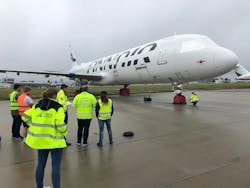Revolutionizing Aviation Ground Support with Digital Twin Technology
Aviation ground support operations demand precision, efficiency, and safety. Technology offers transformative solutions to these complex challenges. We spoke with Nick Karakulko, senior director of critical infrastructure projects & transportation with Hexagon, about how their digital twin and LIDAR capabilities are set to reshape ground handling, moving toward a more automated, safer, and data-driven future.
GSW: How are Hexagon's solutions impacting aviation operations, specifically for ground support?
Karakulko: Hexagon offers tools like HxGN dC3 Orchestrator and HxGN Connect to enhance operations, emergency management, and communications. These platforms integrate various technologies into a unified space. For ground support, this means real-time monitoring through camera feeds and sensor data. If metrics show delays or incidents, our systems alert staff immediately. We can also flag critical sensor malfunctions.
A key recent addition is our digital twin and LIDAR capabilities. Combined with asset management, this allows airports to visualize assets in 3D, detailing installation, maintenance history, and current status. This drastically reduces maintenance time by providing vital information before dispatching personnel.
GSW: Can you provide a concrete example of how a digital twin would work for ground support?
Karakulko: We're exploring the full potential, but one compelling idea came from an airport contact regarding private planes at major events like the Super Bowl. Managing hundreds of private planes on the tarmac is a huge challenge. Imagine a digital twin of the entire tarmac, combined with LIDAR sensors mounted on light poles. These sensors create precise outlines of all planes. If a tug moves a plane too close to another, the system immediately notifies the drivern - perhaps on a tablet or with a flashing light - indicating they're in a buffer zone and need caution. This real-time proximity alert prevents collisions, enhancing safety.
GSW: Is this technology affordable for ground handling companies?
Karakulko: Yes, it's not as expensive as you might think. Many major airports already have digital twins, often updated quarterly. We can integrate that existing data into our software, which isn't prohibitively costly. Deploying one or two LIDAR sensors to monitor a specific area can get you started quickly.
This same technology can reduce incidents involving ground support equipment like fuel trucks, food delivery vehicles, and baggage carts. LIDAR can monitor velocity, ensuring vehicles don't speed or stray from lanes. It can also alert if personnel enter unsafe zones. These systems overlay the digital twin with real-time LIDAR data to manage traffic congestion on the ramp.
GSW: What are the primary benefits for ground handling firms beyond safety?
Karakulko: The immediate benefits are indeed enhanced safety for personnel and the prevention of costly damage to aircraft and equipment. Beyond that, the technology enables precise monitoring and enforcement of safety protocols. For instance, similar to how we ensure workers only access de-energized areas in utilities, at an airport, it can ensure only certified mechanics approach jet engines or that specific areas are cordoned off for certain vehicles or personnel.
While I'm not a ground operations expert, airport professionals have suggested many applications, even tracking coyotes on runways. The digital twin and LIDAR sensors can identify objects, track movement, and distinguish normal from abnormal. If a bag falls off a cart, the system can quickly identify it, swing a camera over, and alert personnel for immediate pickup.
GSW: Do you foresee a future where nearly everything will have a digital twin in aviation ground support and beyond?
Karakulko: The digital twin concept isn't entirely new; what's new is the adoption of this mature technology across industries and the integration of sensors like LIDAR. LIDAR creates a laser mesh over the digital twin, providing exact location, velocity, and identification of everything in that space. This offers an unprecedented view of operations, though its full utilization is still evolving.
GSW: What are some top challenges ground support professionals face that this technology can help address?
Karakulko: Based on what I've heard, cost, safety/liability, and the workforce shortage are key concerns. Our technology can significantly impact all of these. From a safety perspective, with a digital twin and LIDAR categorizing objects (human, car, plane), you can easily establish rules: "these two objects should never come together," "maintain a seven-foot distance," or "velocity should not exceed X."
The technology becomes an automated "police dog," constantly monitoring and alerting when something outside the rules occurs, making operations inherently safer. It allows you to achieve more with less by boosting efficiency and productivity.
GSW: Looking ahead, where do you see this technology heading for ground operations and the broader aviation industry?
Karakulko: I believe airports are moving towards complete digital twins of their entire operations. They'll want to minimize incidents for liability and ensure smooth, efficient operations - preventing lost bags or flight delays due to ramp incidents. These full operational digital twins will allow them to monitor everything like a hawk, with automated alerts that help predict and prevent issues. The goal is to shift from reactive responses to proactive prevention.
The digital twin is also valuable for planning. You can plan how things will operate, and then enforce those plans based on precise digital twin information. This future, where operations are precisely monitored and controlled, isn't limited to airports; it applies to many industries striving for optimal efficiency and safety.
Nick Karakulko, senior director of critical infrastructure projects & transportation with Hexagon


